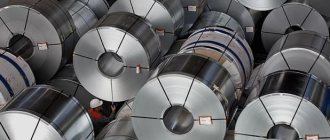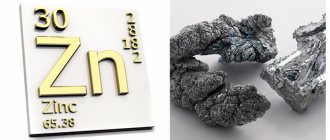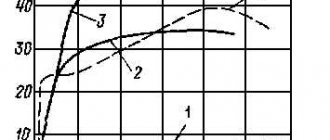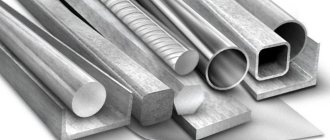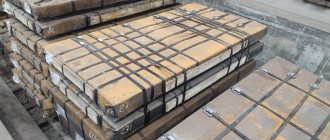08/14/2020 Author: VT-METALL
Issues discussed in the material:
- Useful and special impurities in steel
- Harmful impurities in steel that impair its properties
Harmful impurities in steel not only worsen its composition, but can also lead to subsequent deformation of a product made from it. However, they cannot all be considered undesirable. Some of them are considered useful, while others cannot be gotten rid of at all, since they are permanent. And there is no need to eliminate them, since permanent impurities can affect the quality characteristics of steel.
In this article we will talk about what harmful impurities are in steel and how they affect its composition and the characteristics of steel products.
Impurities: permanent, hidden and random
Manganese, silicon, aluminum, sulfur and phosphorus
are classified as
permanent impurities
.
Aluminum, together with manganese and silicon, is used as a deoxidizer and therefore they are always present in small quantities in deoxidized steels. Iron ores, as well as fuels and fluxes, always contain a certain amount of phosphorus and sulfur, which remain in cast iron and then pass into steel
.
Nitrogen
called
a hidden
impurity - it enters steel mainly from the air.
To random
impurities include
copper, arsenic, tin, zinc, antimony, lead
and other elements. They end up in the steel with the charge - with ores from various deposits, as well as from iron scrap.
All impurities - permanent, hidden and accidental - are inevitable to varying degrees due to steel production technology. Thus, mild steel usually contains these impurities within the following limits: 0.3-0.7% manganese; 0.2-0.4% silicon; 0.01-0.02% aluminum; 0.01-0.05% phosphorus, 0.01-0.04% sulfur, 0.-0.2% copper. In these quantities, these elements are considered as impurities, and in larger quantities, which are intentionally added to steel, they are already considered alloying elements.
What harmful impurities are contained in steels?
MAIN HARMFUL IMPURITIES - SULFUR AND PHOSPHORUS
Harmful impurities also include gases (nitrogen, oxygen, hydrogen)
Sulfur is a harmful impurity - it enters steel mainly with the initial raw material, cast iron. sulfur is insoluble in iron; it forms the compound FeS iron sulfide with it. When interacting with iron, a eutectic (Fe + FeS) is formed with a melting point of 9880 C. Therefore, when steel blanks are heated for plastic deformation above 9000 C, the steel becomes brittle. During hot plastic deformation, the workpiece is destroyed. This phenomenon is called red brittleness. One way to reduce the influence of sulfur is to introduce manganese. The Mns compound melts at 16200 C, these inclusions are plastic and do not cause red brittleness
The sulfur content in steels is allowed no more than 0.06%
Phosphorus also enters steel mainly with the original cast iron, which is also used for steel smelting. Up to 1.2% phosphorus dissolves in ferrite, reducing its ductility. Phosphorus has a high tendency to segregate, so even with an insignificant average amount of phosphorus in the casting, areas rich in phosphorus can always form
Phosphorus located near the boundaries increases the temperature of transition to a brittle state (cold brittleness). Therefore, phosphorus, like sulfur, is a harmful impurity; its content in carbon steel is allowed up to 0.050%
Hidden impurities: This is the name given to the gases present in steel - nitrogen, oxygen, hydrogen - due to the difficulty of determining their quantity. Gases enter the steel during its smelting. In hard steel they can be present, either dissolving in ferrite or forming a chemical compound (nitrides, oxides). Gases can also be in a free state in various discontinuities.
Even in very small quantities, nitrogen, oxygen and hydrogen greatly impair the plastic properties of steel. Their content in steel is allowed 10-2 - 10-4%. As a result of evacuation of steel, their content decreases and properties improve
There are two types of carbon tool steels: high-quality and high-quality
High-quality carbon tool steels are marked with the letter “U” (carbon); the number following it (U7, U8, U10, etc.) shows the average carbon content in tenths of a percent
High-quality steels are marked with the letter "A" at the end (U10A)
Tool carbon steels: They have high hardness (60-65 HRC), strength and wear resistance and are used for the manufacture of various tools
Carbon tool steels U8 (U8A), U10 (U10A), U11 (U11A), U12 (U12A) and U13 (U13A), due to the low stability of supercooled austenite, have low hardenability, and therefore these steels are used for small-sized tools
For cutting tools (mills, countersinks, drills, spiral saws, scrapers, hand saws, files, razors, sharp surgical instruments, etc.), hypereutectoid steels (U10, U11, U12 and U13) are usually used, in which, after heat treatment, structure martensite and carbides
Woodworking tools, chisels, punches, bits, screwdrivers, axes are made from U7 and U8 steels, which have a troostite structure after heat treatment
Carbon steels in the initial (annealed) state have a granular pearlite structure, low hardness (HB 170-180) and are well machined by cutting. The hardening temperature of carbon tool steels U10-U13 should be 760-780 0 C, i.e. slightly higher than Ac1, but lower than Ast, so that as a result of hardening the steel obtains a martensitic structure and retains fine grains and undissolved particles of secondary cementite. Hardening is carried out in water or aqueous solutions of salts. To reduce deformations, small tools made of U10-U12 steels are cooled in hot environments (step hardening)
The influence of phosphorus on the properties of steels
Phosphorus (P) segregates during steel solidification, but to a lesser extent than carbon and sulfur. Phosphorus dissolves in ferrite and thereby increases the strength of steels. As the phosphorus content in steels increases, their ductility and toughness decrease and their tendency to cold brittleness increases.
The solubility of phosphorus at high temperatures reaches 1.2%. With decreasing temperature, the solubility of phosphorus in iron drops sharply to 0.02-0.03%. This amount of phosphorus is typical for steels, that is, all phosphorus is usually dissolved in alpha iron.
Phosphorus has a strong tendency to segregate at grain boundaries, resulting in temper brittleness in alloy steels, especially in manganese, chromium, magnesium-silicon, chromium-nickel and chromium-manganese steels. Phosphorus, in addition, increases the hardening of steels and, like silicon, slows down the decomposition of martensite in steels.
Increased phosphorus content is often specified in low-alloy steels to improve their machining, especially automatic machining.
In low-alloy structural steels with a carbon content of about 0.1%, phosphorus increases strength and resistance to atmospheric corrosion.
In austenitic chromium-nickel steels, phosphorus additions help increase the yield strength. In strong oxidizers, the presence of phosphorus in austenitic stainless steels can lead to grain boundary corrosion. This is due to the phenomenon of phosphorus segregation along grain boundaries.
Useful impurities in steel
If we talk about substances that improve the characteristics of the metal, these include:
- chromium – increases corrosion resistance and hardness; with a high chromium content, steel becomes stainless;
- nickel – increases the strength and ductility of the alloy;
- aluminum – increases heat resistance and resistance to scale formation;
- tungsten – increases the red resistance and hardness of the metal due to the ability to form carbides (superhard compounds);
- cobalt – increases heat resistance and impact resistance;
- titanium – reduces the content of harmful oxygen, increases corrosion resistance and machinability;
- vanadium - like titanium, is considered an effective deoxidizer, increases the density and strength of the metal.
The list is by no means exhaustive; there are other elements that improve the quality of steel. They are used in the smelting of alloy, stainless and heat-resistant steels. You can learn about the composition of the metal from the designation of a particular grade of steel.
The influence of sulfur on the properties of steels
The sulfur (S) content in high-quality steels does not exceed 0.02-0.03%. In general purpose steels, the permissible sulfur content is higher - 0.03-0.04%. By special treatment of liquid steel, the sulfur content in steel is brought to 0.005%.
Sulfur does not dissolve in iron, so any amount of it forms iron sulfide FeS with iron. This sulfide is part of the eutectic, which is formed at 988 °C.
An increased sulfur content in steels leads to their red brittleness due to low-melting sulfide eutectics that arise along grain boundaries. The phenomenon is red
brittleness occurs at a temperature of 800 °C, that is, at the
red-hot
of steel.
Sulfur has a detrimental effect on the ductility, toughness, weldability and surface quality of steels (especially in steels with low carbon and manganese content).
Sulfur has a very strong tendency to segregate at grain boundaries. This leads to a decrease in the ductility of steels in the hot state. However, 0.08 to 0.33% sulfur is deliberately added to steels for automatic machining. It is known that the presence of sulfur increases the fatigue strength of bearing steels.
The presence of manganese in steel reduces the harmful effects of sulfur. In liquid steel, the formation reaction of manganese sulfide occurs. This sulfide melts at 1620 °C - at temperatures much higher than the temperature of hot working of steels. Manganese sulfides are plastic at temperatures of hot processing of steels (800-1200°C) and therefore are easily deformed.
Classification of steel types
Definition 1
Steel is an alloy of iron with carbon and other chemical elements, which contains a minimum of 45% iron and a carbon content ranging from 0.02% to 2.14%.
If the carbon content in steel is from 0.6% to 2.14%, then it is high-carbon. If the carbon content is more than 2.14%, then the alloy is called cast iron. Modern powder steels can contain up to 3% carbon, but they are not cast iron. Carbon reduces toughness and ductility and gives the alloy hardness and strength.
Steels with high elastic properties are widely used in instrument and mechanical engineering. In mechanical engineering they are used to produce power springs for various purposes, shock absorbers and leaf springs. In instrument making, steels are used in the manufacture of relay plates, membranes, springs, suspensions and braces. Steels can be classified according to the following criteria:
Are you an expert in this subject area? We invite you to become the author of the Directory Working Conditions
- Structure. According to this characteristic, steels are divided into pearlitic, austenitic, bainitic, martensitic and ferritic.
- Purpose. According to this criterion, steels are divided into stainless steel, tool steel, structural steel, cryogenic steel and heat-resistant steel.
- Chemical composition. According to this characteristic, steels are divided into alloy and carbon. Carbon ones are divided into low-, medium- and high-carbon, alloyed into low-, medium- and high-alloy.
- Method of receipt. According to this characteristic, steels are divided into steels of ordinary quality, high-quality, high-quality and especially high-quality.
The main characteristics of steel include: density (from 7700 to 7900 kilograms per cubic meter), specific gravity, specific heat capacity, melting point, specific heat of fusion, thermal conductivity, coefficient of linear thermal expansion and tensile strength.
The influence of aluminum on the properties of steels
Aluminum (Al) is widely used for deoxidation of liquid steel, as well as for grain refinement of steel ingots. The harmful effects of aluminum include the fact that it promotes the graphitization of steels. Although aluminum is often considered an impurity, it is also actively used as an alloying element. Because aluminum forms solid nitrides with nitrogen, it is usually an alloying element in nitrided steels. Aluminum increases the resistance of steels to scaling, and therefore it is added to heat-resistant steels and alloys. In dispersion-hardening stainless steels, aluminum is used as an alloying element that accelerates the dispersion precipitation reaction. Aluminum increases the corrosion resistance of low-carbon steels. Of all the alloying elements, aluminum is the most effective for controlling grain growth when heating steels for hardening.
The influence of nitrogen on the properties of steels
The harmful effect of nitrogen (N) is that the rather large, brittle non-metallic inclusions it forms - nitrides - worsen the properties of steel. A positive property of nitrogen is that it is capable of expanding the austenitic region of the phase diagram of steels. Nitrogen stabilizes the austenitic structure and partially replaces nickel in austenitic steels. Nitride-forming elements vanadium, niobium and titanium are added to low-alloy steels. When controlled by hot working and cooling, they form fine nitrides and carbonitrides, which significantly increase the strength of the steel.
The influence of copper on the properties of steels
Copper (Cu) has a moderate tendency to segregate. The harmful effects of copper include a decrease in the cold brittleness of steel. With an increased copper content, it negatively affects the quality of the steel surface during hot processing. However, with a content of more than 0.20% copper increases its resistance to atmospheric corrosion, as well as the strength properties of alloy and low-alloy steels. Copper in amounts greater than 1% increases the resistance of austenitic stainless steels to sulfuric and hydrochloric acids, as well as their resistance to stress corrosion.

